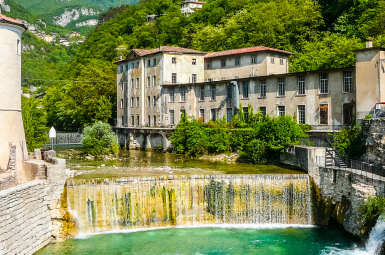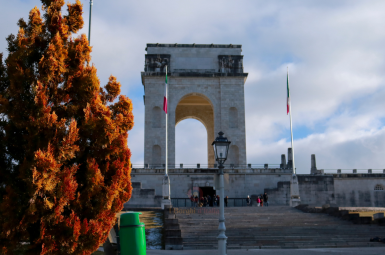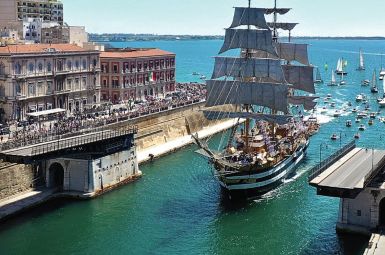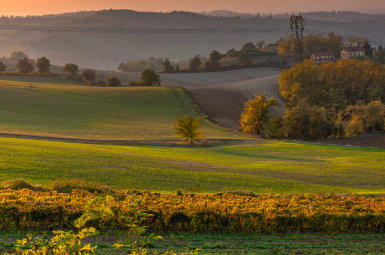
Il Borgo di Bova
Bova: La Capitale della Cultura Grecanica, Un Borgo Sospeso tra Storia e Mito
Arroccata sulle pendici aspre e maestose dell’Aspromonte, con lo sguardo rivolto al Mar Ionio e, nelle giornate più limpide, fino all’Etna, Bova non è solo un borgo, ma un vero e proprio santuario della memoria. Riconosciuta tra “I Borghi più Belli d’Italia”, questa gemma della Calabria meridionale è la capitale indiscussa della Bovesìa o Area Grecanica, un’isola linguistica e culturale che preserva un patrimonio millenario unico in Italia.L’Eredità Ellenica: La Chòra della Calabria Greca
Bova, anticamente conosciuta come Vùa (probabilmente dal greco boua, che significa gregge o bue), è la Chòra – il centro principale – di un territorio dove la lingua e le tradizioni della Magna Grecia hanno resistito all’oblio.- Il Grecanico Vivo: Qui, nelle vie in pietra del centro storico, si può ancora sentire l’eco del greco di Calabria (o grecanico), un idioma antichissimo di derivazione greco-bizantina. Bova è l’epicentro del recupero e della valorizzazione di questa minoranza linguistica, ospitando il Museo della Lingua Greco-Calabra “Gerhard Rohlfs”, dedicato al linguista tedesco che ne studiò l’unicità.
- Feste e Rituali Bizantini: La profonda influenza orientale si manifesta nei riti, come la solenne Pasqua Bizantina, e nelle tradizioni folcloristiche, tra cui le famose “Pupazze” (o Persone) addobbate con ramoscelli d’ulivo e fiori durante la Domenica delle Palme, un’antica usanza propiziatoria.
Architettura e Panorama: Un Fortilizio sulla Rocca
L’assetto urbanistico di Bova è quello tipico del borgo medievale di rifugio, costruito per difesa contro le incursioni saracene, ma impreziosito da secoli di influenza ecclesiastica e nobiliare.- Il Castello Normanno: Sulla vetta più alta si ergono i suggestivi ruderi del Castello Normanno, in origine una fortificazione bizantina. Sebbene restino solo poche mura, il sito offre la visione più spettacolare sul borgo sottostante e sulla vasta vallata che degrada verso la costa.
- La Cattedrale dell’Isodia (Santa Maria dell’Isodia): Vero e proprio cuore spirituale del paese, questa concattedrale vanta un’architettura che mescola stili, e custodisce pregevoli opere d’arte, tra cui sculture di artisti rinascimentali come Rinaldo Bonanno.
- Il Centro Storico Museo: Le strette vie acciottolate ospitano palazzi tardo-barocchi e settecenteschi, con portali in pietra scolpita. Il borgo stesso è un Sentiero della Civiltà Contadina, con oggetti della vita agro-pastorale esposti lungo il percorso, trasformando l’abitato in un museo diffuso.
Bova è una destinazione per chi cerca un viaggio che sia un’immersione profonda: nella storia che non muore, in una cultura che resiste, e in un paesaggio che combina la potenza della montagna con l’immensità del mare. È l’essenza stessa della Calabria, fiera, antica e indimenticabile.
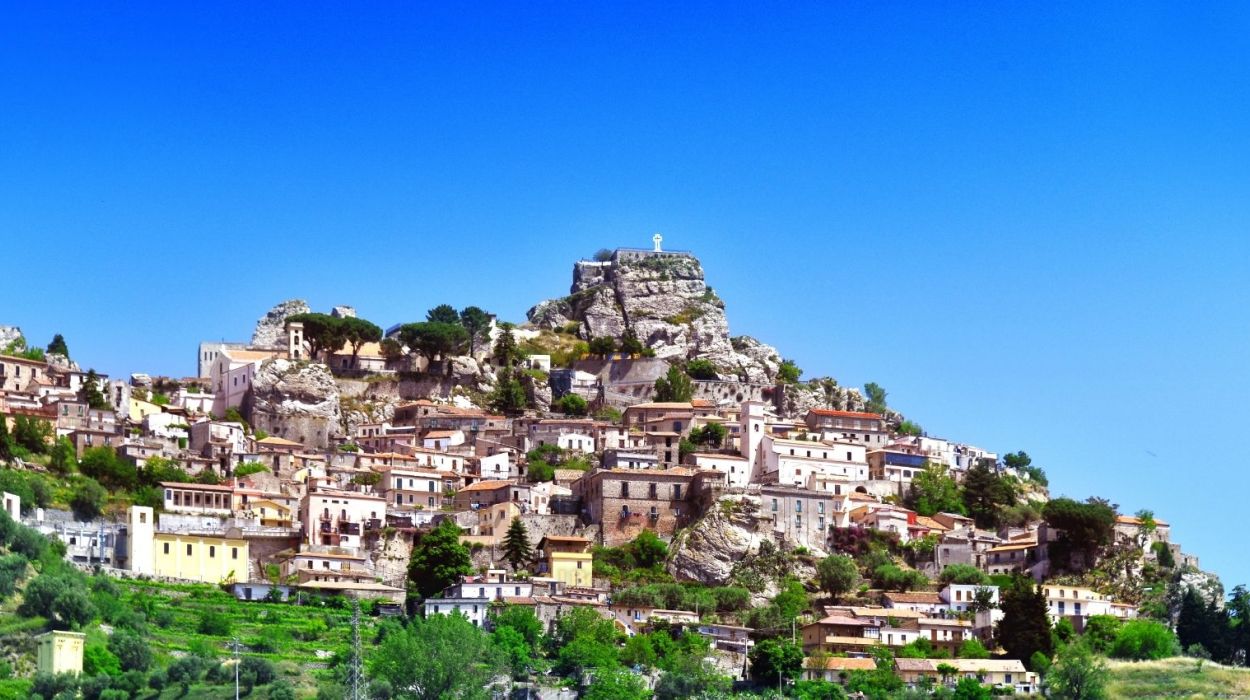
Il Borgo d’Italia
tutto da scoprire ed esplorare
Monumenti
Bova: Monumenti, Sentinelle di Storia e Custodi dell’Ellenofonia
Visitare Bova non è un semplice viaggio, ma una vera e propria immersione nell’archeologia della memoria. Ogni pietra, ogni arco e ogni rudere di questo borgo, eletto tra i più belli d’Italia, racconta secoli di stratificazioni culturali, dal Neolitico all’epopea Grecanica. I suoi monumenti sono i testimoni silenziosi di una storia unica, dove l’Oriente bizantino incontra il cuore della Calabria.
La Cittadella Fortificata: Il Castello Normanno
Dominando l’intero crinale, a 915 metri di altitudine, si erge fiero il Castello Normanno. Ciò che resta di questa maestosa sentinella è un rudere carico di evocazione, costruito su preesistenze bizantine per fronteggiare le minacce saracene dal mare.
Esso incarna il punto di fusione tra strategia militare e leggenda: si narra che proprio sulla rocca, la mitologica regina greca Oichista abbia lasciato l’impronta del suo piede, a sigillare un legame indissolubile tra Bova e le sue radici elleniche. Oggi, il sito offre un belvedere incomparabile, una vista che abbraccia il massiccio dell’Aspromonte e si perde nell’infinito azzurro dello Ionio, con lo skyline dell’Etna sullo sfondo.
Il Cuore Spirituale e Artistico: Cattedrale e Chiese
La spiritualità di Bova si manifesta in capolavori architettonici che narrano la transizione dal rito greco a quello latino.
- La Cattedrale di Santa Maria dell’Isodia: Un simbolo di fede millenaria. Sebbene rimaneggiata nel corso dei secoli, questa concattedrale conserva elementi romanici e, soprattutto, custodisce un patrimonio artistico di inestimabile valore. Al suo interno, spicca la Madonna dell’Isodia, una scultura marmorea attribuita al celebre artista siciliano del Cinquecento, Rinaldo Bonanno, emblema dell’arte sacra calabrese.
- La Chiesa di San Leo: Edificata sui resti di un antico luogo di culto, questa chiesa è dedicata a San Leo, il santo originario di Bova. Rappresenta una tappa fondamentale per la devozione locale, custode delle reliquie del santo e di una preziosa scultura del 1582 che la tradizione attribuisce alla scuola di Bonanno o a Pietro Bernini.
I Musei: La Memoria Viva della Chòra
Bova non si limita a esporre il suo passato, lo mantiene vivo attraverso istituzioni culturali di primaria importanza.
- Museo della Lingua Greco-Calabra “Gerhard Rohlfs”: È il baluardo identitario di Bova. Un luogo sacro per la cultura grecanica, dove l’antico idioma ellenofono viene studiato, celebrato e tramandato, rendendo Bova un unicum nel panorama linguistico europeo.
- Sentiero della Civiltà Contadina: Passeggiando tra i vicoli, si compie un viaggio a ritroso nel tempo. Questo museo all’aperto trasforma le strade e le vecchie botteghe in una galleria di vita rurale, esponendo gli strumenti e gli oggetti della tradizione agro-pastorale che per secoli hanno scandito l’esistenza della comunità.
- Il Museo Civico di Paleontologia e Scienze Naturali dell’Aspromonte: Per gli amanti della natura e della scienza, questo museo offre una collezione straordinaria di reperti fossili, ponendo Bova al centro della conoscenza geologica e naturalistica del Parco Nazionale dell’Aspromonte.
Infine, un monumento al sentimento: la Locomotiva a Vapore 740.054, posta in Piazza Ferrovieri d’Italia, è un toccante omaggio agli emigrati che lasciarono la loro terra, simboleggiando il legame tra Bova e il mondo, un ponte tra partenze e promesse di ritorno.
Bova non è un catalogo di monumenti statici, ma un teatro a cielo aperto
Curiosità
Bova: Cinque Curiosità sulla Capitale del Tempo e del Mito
Bova, la “Chòra” (città) dell’Area Grecanica calabrese, è molto più di un borgo arroccato. È un giacimento vivente di storia ellenica nel cuore dell’Aspromonte. Le sue curiosità affondano nella linguistica, nel mito e in una tradizione unica che la rende incomparabile.
1. Il Segreto della Lingua: L’Ultimo Baluardo Ellenofono
Bova è universalmente riconosciuta come la capitale morale e culturale della Bovesìa, l’area che parla il greco di Calabria (o grecanico).
- L’Eredità di Omero: Il grecanico non è un dialetto, ma un idioma antichissimo di derivazione greco-bizantina, un’affascinante reliquia linguistica della Magna Grecia. Bova è il centro più attivo nella sua salvaguardia, grazie anche al Museo della Lingua Greco-Calabra “Gerhard Rohlfs” che ne celebra la storia e la diffusione.
- “Due Volte Greca”: Questo è il motto del paese, a sottolineare la sua duplice anima: l’antica radice magnogreca e la lunga influenza bizantina che ne ha plasmato l’identità religiosa e culturale fino al XVI secolo.
2. Il Mistero della Regina Oichista e della “Pietra Cappa”
Le origini di Bova sono avvolte nel mito di una figura femminile leggendaria.
- L’Impronta Reale: La leggenda narra che Oichista, una regina greca, sia stata la fondatrice del borgo. Si dice che abbia lasciato l’impronta del suo piede sulla roccia più alta della sommità, un gesto simbolico per stabilire il suo dominio e il legame eterno con la terra.
- Sentinella di Pietra Cappa: Dai belvederi di Bova si gode una vista eccezionale su tutta la vallata e sulla famosa Pietra Cappa, il monolite più grande d’Europa. Questa imponente roccia, visibile in lontananza, è parte del Geoparco Aspromonte UNESCO e aggiunge un elemento di maestosa geologia al panorama culturale di Bova.
3. Le “Pupazze”: Un Rito Propiziatorio Unico in Italia
Una delle tradizioni più singolari e colorate di Bova si svolge durante la Settimana Santa.
- Pasqua Bizantina: A Bova, la Domenica delle Palme si celebra con la processione delle “Pupazze” (in grecanico, Persone). Queste sono grandi figure antropomorfe, a volte alte quasi due metri, realizzate con scheletri di canne e interamente decorate con rami d’ulivo, alloro, fiori e persino frutti.
- Simbolo di Fertilità: Questo rito pagano cristianizzato ha un profondo significato propiziatorio, invocando la fertilità della terra e un buon raccolto per l’anno a venire. È una fusione spettacolare di fede e folclore che attira visitatori da ogni dove.
4. La Targa per gli Emigranti: Il Treno della Memoria
Bova ha saputo trasformare un segno di abbandono in un monumento alla speranza e al ricordo.
- La Locomotiva 740.054: In una delle piazze del borgo è esposta un’imponente locomotiva a vapore, la 740.054. Non è lì per caso: simboleggia i treni della Ferrovia Jonica che partivano dalla vicina Bova Marina, portando via intere generazioni di calabresi costretti a emigrare.
- Omaggio alla Dignità: La locomotiva è oggi un toccante e dignitoso monumento all’emigrazione, un punto di riflessione sul legame indissolubile tra gli Bovesani e la loro terra, ovunque essi si trovino.
5. Una Storia di Trasformazione Religiosa: L’Ultima Diocesi Greca
Bova è stata un cruciale punto di resistenza per il rito greco-bizantino.
- Resistenza Liturgica: La Diocesi di Bova fu una delle ultime in Italia a mantenere il rito greco, prima che le norme post-Concilio di Trento imponessero il rito latino nel 1572. Questa resistenza plurisecolare è la chiave per comprendere la sua profonda e radicata identità orientale, che pervade ancora oggi la sua cultura e architettura religiosa.
Personaggi
I Fari della Grecanica: Le Personalità che Hanno Reso Immortale Bova
Bova, più che un borgo, è la culla di una civiltà, e i suoi figli più illustri non sono stati re o condottieri, ma custodi della lingua e della memoria. Le figure nate in questa Chòra dell’Aspromonte hanno dedicato la loro vita a preservare l’identità unica del popolo grecanico, proiettando la sua cultura oltre i confini montani.
I Poeti Custodi della Lingua Antica
L’eredità più luminosa di Bova risiede nella sua tradizione poetica, un baluardo in versi contro l’oblio del tempo.
Bruno Casile: Il “Poeta Contadino” di Pasolini
Nato a Bova nel 1923, Bruno Casile è il simbolo della resistenza culturale grecanica.
- La Scoperta d’Autore: La sua notorietà si deve a Pier Paolo Pasolini che, folgorato dalla forza espressiva e dalla passionalità delle sue liriche, lo definì l’emblematico “poeta contadino”.
- L’Impegno per la Sopravvivenza: Casile utilizzò il grecanico come strumento primario per la sua poesia, fondando l’associazione culturale “Apodiafazzi” (che significa “risveglio”) e dedicando la sua opera al non far perdere la “bella lingua della stirpe”. Le sue poesie, raccolte in volumi come Strafonghìa sto scotùdi (Bagliore nel buio), sono un inno alla sua terra, all’emigrazione forzata e alla dignità del lavoro contadino.
Agostino Siviglia: Il Virtuoso della Versificazione Grecanica
Figura centrale nella cultura della Bovesìa, Agostino Siviglia (sebbene nativo di Chorìo di Roghudi, è intimamente legato a Bova dove visse e operò) è considerato tra i più virtuosi interpreti della poesia popolare dell’area.
- Voce dell’Identità: Le sue composizioni in grecanico risuonano come inni potenti alla terra e alla necessità di tramandare l’antica parlata. La sua poesia è un appello commosso e fiero, un invito continuo a “venire a imparare la lingua antica”. Siviglia ha saputo trasformare i sentimenti popolari in versi eleganti, diventando un faro per le nuove generazioni.
Le Figure Istituzionali e i Carbonari Illuminati
Oltre ai poeti, Bova ha dato i natali a personalità che hanno lasciato un segno negli ambiti istituzionali e storici, spesso animate da forti ideali risorgimentali.
- I Fratelli Catanea: Figure di spicco del XIX secolo, Alfredo e Antonio Catanea furono profondamente legati alla loro città natale. Appartenenti all’associazione carbonara “Il sasso forte all’ordone di Bova” in periodo prerisorgimentale, Alfredo in particolare si distinse come avvocato e studioso, dedicando meticolosi lavori alla ricostruzione della storia patria bovese.
Bova si rivela, quindi, come una terra che non solo ha resistito al tempo, ma ha saputo generare personalità in grado di fare della propria identità culturale un’opera d’arte e un impegno civile.
Ricette Tipiche
L’Anima Grecanica nel Piatto: Le Ricette Maestose di Bova
La cucina di Bova non è una semplice gastronomia: è il palinsesto dei sapori dell’Aspromonte Greco, dove l’antica tradizione agro-pastorale incontra l’influenza bizantina e la sapidità del vicino Ionio. I piatti tipici di Bova sono un inno agli ingredienti poveri, trasformati dalla sapienza delle massaie in vere e proprie esperienze culinarie.
Qui, la tavola è un viaggio nel tempo, dove ogni ricetta custodisce la forza e la genuinità della Chòra.
1. Il Primo Piatto Sovrano: I Maccarruni cu Sugo di Capra
Se Bova ha un re in tavola, è senza dubbio il Maccarruni i Casa (Maccheroni fatti in casa).
- L’Arte del Ferretto: Questa pasta fresca viene realizzata interamente a mano, arrotolando l’impasto di semola e acqua intorno a un sottile ferro da calza o un apposito ferretto. Ne risulta un maccherone cavo, poroso e perfetto per trattenere sughi robusti.
- Il Ragù dell’Aspromonte: Il condimento d’elezione è il ricco Sugo di Capra. La carne, tipica dell’allevamento locale, viene cotta lentamente per ore con cipolle, alloro e una salsa di pomodoro concentrata, conferendo al ragù un sapore intenso, selvatico e inconfondibile. A fine cottura, l’aggiunta di una spolverata di ricotta salata grattugiata esalta il contrasto di sapori.
2. Il Simbolo del Borgo: La Lestopitta
Nessuna visita a Bova è completa senza assaggiare la sua iconica street food ancestrale: la Lestopitta.
- L’Antico Pane Azimo: Il nome, che alcuni fanno derivare dal greco “pane sottile” ($\Lambda\epsilon\pi\tau o ́\varsigma$ – leptòs e $\pi i ́\tau\tau \alpha$ – pitta), descrive una semplicissima focaccia non lievitata, preparata solo con farina di grano duro, acqua e sale.
- Croccantezza Istantanea: L’impasto viene steso in dischi sottilissimi e fritto in olio bollente (o strutto), gonfiandosi quasi magicamente e assumendo una consistenza croccante all’esterno e morbidissima all’interno.
- L’Esaltazione del Ripieno: La Lestopitta è nata come pasto rapido per i pastori e si gusta rigorosamente calda, farcita con i tesori dell’Area Grecanica: salsiccia fresca, formaggi pecorini locali o semplicemente accompagnata da peperonata e un filo del potentissimo olio EVO calabrese.
3. Il Tesoro Casaro: La Musulupa
Dolce, fresco e intriso di ritualità, la Musulupa non è un semplice formaggio, ma un’opera d’arte popolare.
- Forma e Mito Pasquale: Prodotto tipico dell’Area Grecanica, è un formaggio fresco (non salato) tradizionalmente modellato in occasione della Pasqua in specifici stampi di legno intagliato chiamati Musulupare.
- Icone Popolari: Le forme sono spesso a disco o, in modo suggestivo, antropomorfe (simboleggianti figure sacre come la Madonna o animali). Questo formaggio racchiude antichi significati rituali ed è l’emblema della vocazione pastorale del territorio.
4. Sapori Secondari e Dolcezze Tradizionali
La cucina di Bova si completa con secondi robusti e dolci legati alle festività.
- Carne di Capra alla Vutana: La capra, oltre al sugo, è protagonista come seconda portata, cucinata alla vutana: tagliata a pezzi e cotta in umido lentamente (anche 5-6 ore) con aceto, vino bianco, cipolla e aromi, fino a raggiungere una tenerezza e un sapore intenso.
- I Dolci della Festa (Petràli e ‘Ngute): A Natale si preparano i Petràli, dolci ripieni di fichi secchi, mandorle, noci, miele e vino cotto. A Pasqua, invece, trionfano le ‘Ngute (o Cuddure), dolci di pasta frolla decorati con uova sode e modellati in forme simboliche (a treccia, a pupa o a campana), che uniscono gusto e rito.
Immergersi nei sapori di Bova significa onorare una tradizione gastronomica che ha saputo conservare intatto il suo carattere greco e montano, offrendo un gusto autentico, schietto e profondamente radicato nella sua terra.
